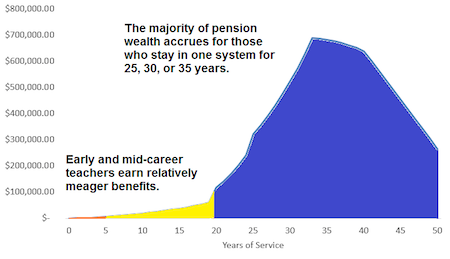There’s been a persistent myth that when it comes to retirement plans, “pension” means “better.” Hearing the word “pension,” many people are led to believe this means a secure and comfortable retirement. After all, pensions mean a guaranteed lifetime annuity. The Seattle Times even recently published an article listing the last few jobs that still offer traditional pensions, as a way for jobseekers to scoop up positions that offer these supposedly better retirement plans.
But the big error in reasoning, here, lies in the fact that not all pensions are equal. A worker might be promised a pension for life, but the amount of that benefit varies greatly, depending on her years of service.
Take a look at the net pension benefits, after a teacher’s own contributions, for a teacher in Colorado. Teachers who work for five to even 20 years receive relatively little net benefit. The orange and yellow shading take up only a small slice of benefits, compared to the mountain of benefits earned by a teacher who stays for thirty plus years. Can’t see the sliver of orange very well? That’s because early career teachers earn minimal benefits based on their low years of service, lower salaries, and delay in collecting benefits until years later when benefits have eroded away from inflation. In terms of dollars, a teacher who works in the classroom for a total of five year earns a lifetime net benefit worth about $6,800 in today’s dollars, whereas a teacher with 35 years earn a benefit of over $680,000—a hundred times what the early career teacher earns.

TeacherPensions.org, 2015.
Click to enlarge
When people think of pensions as reliable and ample retirement income, they’re really thinking of the blue part of the graph. But in reality, only a small minority of workers actually reach this level of wealth. In Colorado, only 7 percent of teachers are expected to remain in the classroom for 30 years and reach peak benefits, according to plan assumptions. The majority of teachers, on the other hand, more likely will have benefits closer to the orange or maybe yellow section on the graph. To make matters worse, 40 percent of all public school teachers, including those teaching in Colorado, are not eligible to participate in Social Security, placing even more weight on a system that isn’t serving the majority of its members well. (Most people don’t realize that many teachers are uncovered, and this fact failed to make the rose-colored job list posted by the Seattle Times.) Pensions are supposed to be the mainstay for retirement, but few will get adequate benefits and instead will have to rely on other sources of income or work longer to ensure a secure retirement.
And this isn’t just a problem in Colorado. The majority of states place teachers–and public sector workers in general–in traditional pension plans that have the same backloaded structure. In New York, for example, benefits accrue in such an uneven pattern that teachers earn roughly $3,500 per year of work for the first 20 years of service while earning $30,000 per year for teaching years 30 through 38. In Illinois, net pension benefits are actually negative for a 25-year-old teacher who teaches anything less than 26 years. Meanwhile, an Illinois teacher who stays for a total of 30 years receives a net lifetime pension benefit of $389,000. In California, teachers earn negative benefits during the first two decades of work, but a teacher who works for 40 years will receive an annual pension of over $90,000.
Granted, this isn’t to say that career teachers shouldn’t earn greater pension benefits. Veteran teachers who remain in the classroom for 30 plus years should be rewarded for their long-term commitment to the profession and their students. But, the magnitude of inequity and disproportionate allocation of benefits in the current system warrants a policy change.
The next time you hear the word “pension,” think twice before jumping to any conclusions. Because for most people, a pension unfortunately won’t lead to a cushy retirement.
—Leslie Kan
This post originally appeared on TeacherPensions.org


